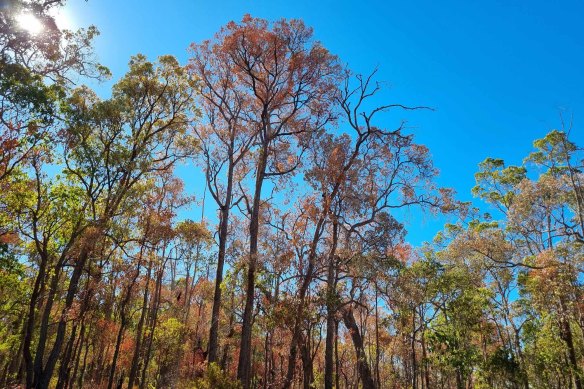This was published 1 year ago
Drying and dying: South West forests face potential ‘collapse’
By Peter Milne
Perth’s gardens have been kept alive with desalinated water over the driest six months in the city’s history, but beyond the reach of sprinklers native vegetation from Kalbarri to Albany is dying from a summer without end.
Jess Boyce, acting director of the WA Forest Alliance, declared it a climate and ecological emergency.
“Large areas of drying and dying vegetation are being seen all around south-west WA, their root systems are running out of water,” she said.
In 2011, the Northern Jarrah Forest that stretches from inland of Perth to Collie suffered a forest collapse – believed to be the first such event in the world – but in 2024, the damage is more widespread.
Climate scientist Bill Hare said this damage was driven by global warming from the burning of fossil fuels.
“This is not the new normal, it is the beginning of what looks like a very, very worrying period of decades ahead,” Hare said.

Trees dying near Donnybrook, WA.Credit: Val Bedford
“The loss of many of our beautiful, unique and biodiverse ecosystems will inevitably come with devastating bushfires.
“People throughout the region are upset, angry and anguished by what they see happening to their favourite places they and their parents and grandparents grew up in.”
Hare, the chief executive of policy institute Climate Analytics, said rainfall in the south-west had dropped 20 per cent since the 1970s and the UN’s Intergovernmental Panel on Climate Change had warned the northern jarrah forest could collapse.
“This should be no surprise to anyone here who’s been paying attention,” he said.
Fauna will feel the effect as their habitats and food sources die. Birdlife Australia’s Sam Rychen said the endangered Carnaby’s black cockatoo, already suffering from habitat loss, could become unsustainable.
In the forests, jarrah, marri, flooded gum, banksia and sheoak trees have experienced die-off, according to the WA Department of Biodiversity, Conservation and Attractions, as well as understorey species near the coast.
“There are similarities to the 2011 die-off event, in that it is being recorded in some parts of the Northern Jarrah Forest, particularly in shallow soils around granite outcrops,” a department spokeswoman said.
The department, with universities, is studying the extent of the die-off using satellites, aircraft, drones and on-the-ground inspections. It plans to map where vegetation is most vulnerable to die out and, in the longer term, thin the forest in these areas to reduce competition for water.
“Agriculture, like the environment, is paying the cost of climate change”
Simon Wallwork
Agriculture is suffering as well.
Corrigin famer Simon Wallwork said many locations in the Wheatbelt have had their driest period on record during the past 18 months.
“Over the last two decades farmers – through technology, innovation and scale – have successfully adapted to a drying, and warming climate,” he said.
“Our adaptive capacity is now being tested.”
Wallwork, who chairs farming and climate croup AgZero2030, said areas once considered reliable for rainfall were now affected. Many livestock farmers had little water, were having to buy expensive feed and got little for their stock as sells offs had depressed prices.
Wallwork said rural communities were increasingly called on as volunteers to respond to fires and storm while their numbers were falling as farms grow to reduce costs and remain competitive
“Agriculture, like the environment, is paying the cost of climate change,” he said.
“But the full costs are never considered are never considered when new high-emitting fossil fuel projects are approved and developed.”
Hare called on the state government to better plan for the WA to adapt to a warming world and to tackle the root cause.
“What we know from the science is that unless we reduce fossil fuel use rapidly – both here and globally – these problems are just going to get worse,” he said.